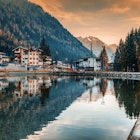
Seven reasons to visit Friuli Venezia Giulia, Italy's intriguing borderland
Oct 14, 2015 • 5 min read

Lake Sauris in the Carnic Alps
Writers Hemingway, Rilke and Joyce all found inspiration in the tiny, triple-barrelled Friuli Venezia Giulia region, tucked away in the far northeast of Italy.
Today, despite being just a couple of hours from Venice, FVG is one of Italy’s least touristed regions, but those in the know are heading here for cultured cities, deliciously wild landscapes and the fascinating Slovenian-Croatian-Austrian-Italian cultural mash up.
- placement: fullWidth
- path: articles/in-content-top
- possible size: [970, 250], [970, 90], [728, 90], [300, 250], [320, 50], [1, 1],
- targeting:
{ "url": "seven-reasons-to-visit-friuli-venezia-giulia-italys-intriguing-borderland" }

Habsburg cafe culture in Trieste
The former free port of Trieste blossomed in the 18th and 19th centuries under the Habsburgs, becoming a vibrant and fluid border zone whose grand cafes were filled with Italian, Slovenian, Croatian, Yiddish, German and Greek chatter. Today its cosmopolitan spirit, elegant architecture and penchant for pork knuckle and sauerkraut still reflects this not-so-distant Austrian past.
Wander the grand avenues and drink a hometown Illy espresso in the grand Mittel-European cafes where James Joyce finished Dubliners and began Ulysses, such as Caffè San Marco. Swim in 19th-century gender-segregated sea baths and breathe in the city’s melancholy coastal beauty from Europe’s largest sea-facing square, Piazza dell'Unità d'Italia.
Roman ruins at Aquileia
Much of the 2nd-century AD Roman megacity of Aquileia lies unexcavated beneath the fields of the eponymous small Friulian town, but there’s still plenty to see above ground. The highlight is an exquisite 4th-century mosaic floor preserved in a 12th-century Gothic basilica which, at 760 square metres, is one of the largest Roman mosaics in the world. Glass walkways allow you to admire the astonishingly vivid depictions of episodes from the Bible, lagoon sealife and wealthy patrons.

You can also stroll the former banks of Porto Fluviale, the old port, which once linked the settlement to the sea, and explore the partially restored remains of houses, roads and the columns of the city’s forum. The old-school Museo Archeologico Nazionale is stuffed to the rafters with northern-Italy’s best collection of Roman artefacts.
Wine tasting at the source
Friuli’s Friulano, Ribolla Gialla and Malvasia are the darlings of smart wine lists the world over, but the experience of drinking the region’s wonderful whites and cultish orange wines on their home soil is an altogether more laid back affair.
- placement: fullWidth
- path: articles/in-content-middle
- possible size: [970, 250], [970, 90], [728, 90], [300, 250], [320, 50], [1, 1],
- targeting:
{ "url": "seven-reasons-to-visit-friuli-venezia-giulia-italys-intriguing-borderland" }

The Collio Goriziano, Colli Orientale and Carso DOCs (certified growing regions) are less than an hour’s drive apart, but offer an incredible variety of landscapes and winemaking styles. Cellar door dining is equally diverse: opt for vertical tastings and fine dining at Bastianich’s Orsone or the genteel rusticity of Valter Scarbolo’s La Frasca.
Up in the Carso, the rocky, hilly strip between the Gulf of Trieste and Slovenia, the tradition of osmize (pop-up tastings at vineyards), still prevails. Follow the trail of tree branches tacked to arrowed signposts at country crossroads and you’ll soon be sampling the latest vintages of the powerful and addictive local white Vitovska by the jug, with platters of local cured meats and cheeses to keep you tidy.
Coastal paths and mountain passes
Whether you’re up for gentle, poetic strolls or hardcore vertical ascents, this region offers fabulously diverse landscapes to explore. In the Carnic Alps, stroll wildflower-dotted fields between Sauris di Sopra and Sauris di Sotto, or embark on a high-altitude trek through woodlands and upland meadows to see the Dolomites from the Sella di Razzo pass.

Down on the Duino coastline, the path that inspired poet Rainer Maria Rilke’s Duino Elegies is now an easy but extremely beautiful 1.7km trail from the Castello di Duino to the town of Sistiana. The holly oak and hornbeam lined path takes you along a limestone cliff tumbling towards the sea.
A feast of ham and cheese
Friuli’s is a cuisine that not only tells the story of the land and the seasons, but also hundreds of years of shifting borders and cultural exchange. Over in western cities Pordenone and Sacile, and in seaside Grado, seafood dishes have a Venetian grace and lightness. Up north, Germanic elements are strong and to the east, Austrian traditions – say hearty pork, bean and cabbage soups – and bold Slavic elements – ravioli stuffed with beetroot and mountain herbs and boozy nut-filled putizza cakes – dominate.
- placement: native
- path: articles/in-content-native
- possible size: [f, l],
- targeting:
{ "url": "seven-reasons-to-visit-friuli-venezia-giulia-italys-intriguing-borderland" }

The ubiquitous local Montasio cheese is combined with shredded potato to make frico, served either as a crispy fried snack or as a soft, potato pancake dish, but prosciutto is the region’s most famous export. San Daniele’s nutty hams have found worldwide fame, and inspired an annual festival, the Aria di Festa, while sweet, unctuous d'Osvaldo from the Collio region attracts its own select but growing number of devotees.
Spritz-o-clock in Udine
Losing its regional-capital status to Trieste in the 1950s may have been something of a blow for Udine but this confident, compact city remains Friuli’s cultural capital today. You may be lured here to see the Tiepolo frescoes (the Oratorio della Purità chapel’s single ceiling featuring a beautiful depiction of the Assumption is worth a visit on its own) but you’ll make repeat visits for the city’s ever convivial wine bars.

Spritz-o-clock seems to start earlier here than anywhere else in Italy, with the festive Veneziana – Aperol and prosecco – drunk at terrace tables from 11am. Aperitivo here is a cheap and particularly cheerful affair with a spritz averaging €2 and toast topped with prosciutto, cheese or smoked fish for €1 or so a pop.
Deep snow and uncrowded skiing
With popular Dolomites ski resorts just over the border in Veneto and Südtirol, it’s no wonder that Friuli’s own Dolomites and Julian Alps are often overlooked as a ski destination.

But the vertical walls, high peaks and deep valleys of Forni di Sopra and the wooded valleys, rustic mountain huts and deep, deep snow (sometimes until May) of Tarvisio and Sella Nevea make for a for an utterly unspoilt and starkly beautiful place to ski, snowboard, cross-country, snow-shoe or dog sled. The resorts’ proximity to the Austrian border means you can also sample the slopes of two countries in one trip.
Getting to Friuli Venezia Giulia
Friuli Venezia Giulia airport is 33km northwest of Trieste, with daily flights from Rome, London and Munich. Venice’s Marco Polo and Treviso airports are within easy reach of the region and have flights to many more destinations.
- placement: fullWidth
- path: articles/bottom
- possible size: [970, 250], [970, 90], [728, 90], [300, 250], [320, 50], [1, 1],
- targeting:
{ "url": "seven-reasons-to-visit-friuli-venezia-giulia-italys-intriguing-borderland" }
Explore related stories


 Art and Culture7 of 2024's best TV and movie locations to inspire your travels
Art and Culture7 of 2024's best TV and movie locations to inspire your travelsJul 18, 2024 • 7 min read
 ActivitiesYou’ve probably never been to Madonna di Campiglio in the Italian Dolomites. Here’s why you should go
ActivitiesYou’ve probably never been to Madonna di Campiglio in the Italian Dolomites. Here’s why you should goMay 23, 2024 • 6 min read





 Food and DrinkFrom Ghent to Istria: discover Europe's hidden culinary destinations
Food and DrinkFrom Ghent to Istria: discover Europe's hidden culinary destinationsFeb 1, 2024 • 14 min read
